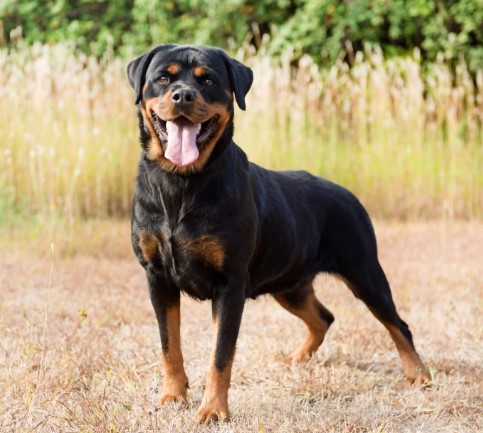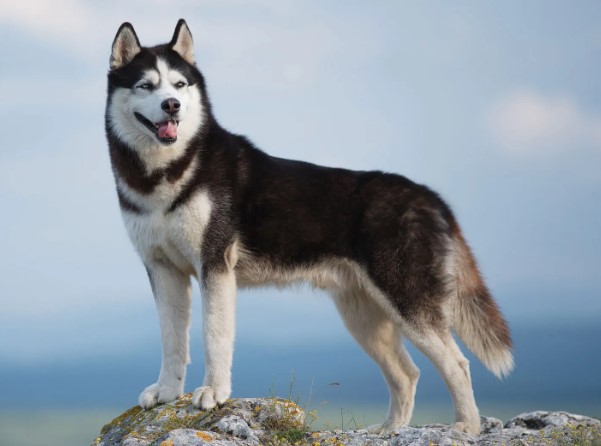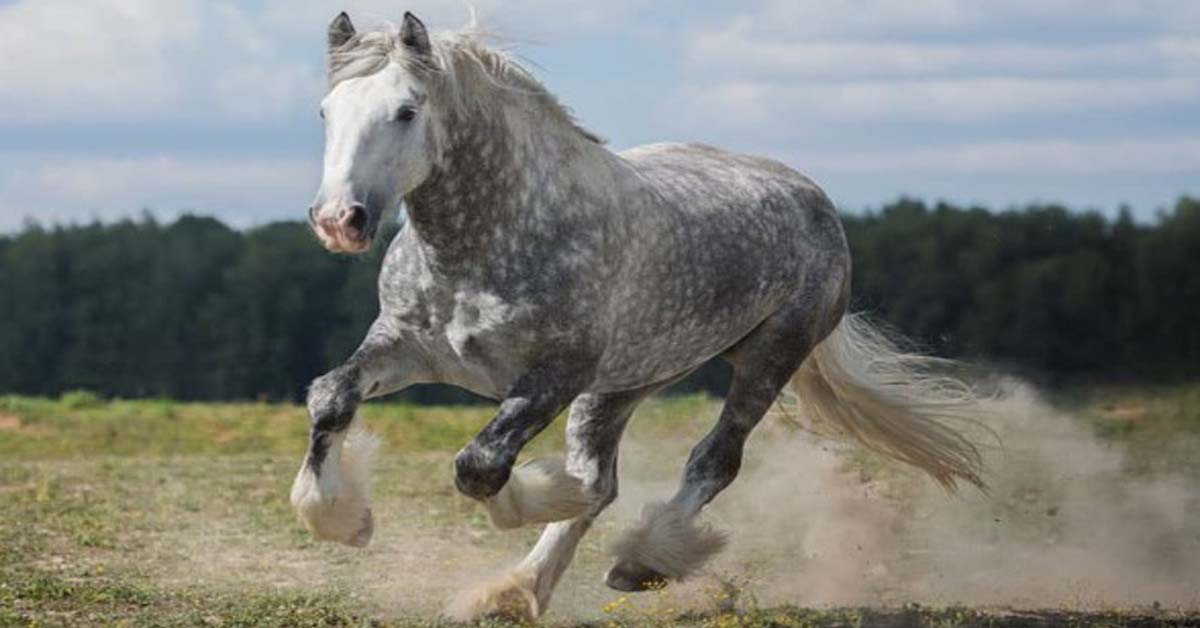The Husky Pug mix, also known as the ‘Clinch’ or ‘Pugsky,’ is the result of crossbreeding a Siberian Husky with a Pug. Although not officially recognized by the AKC, this hybrid is becoming increasingly popular.
The exact origin of the first Husky Pug mix is unclear, but it is believed to have been bred primarily for its appearance rather than for practical work purposes. Regardless of their origin, the Husky Pug is undeniably a visually interesting breed.
If you’re thinking about adopting a Husky Pug, keep reading! In this guide, we’ve covered everything you need to know about this hybrid, including exercise habits, basic care requirements, appearance traits, and common health conditions. Let’s get started on exploring this unique crossbreed!
- Size: Small to medium
- Weight: 40 – 50 pounds
- Height: 20 – 23 inches
- Lifespan: 12 – 15 years
- Coat Colors: White, Fawn, Red, Gray, Black
Husky Pug Mix Breed Characteristics
The mix of Siberian Husky and Pug, known as a newer hybrid, is gaining popularity among dog owners. This crossbreed combines two distinct canine breeds – the Siberian Husky and the Pug – resulting in a dog that inherits traits from both worlds.
The Siberian Husky, originally bred in Siberia, is a medium to large-sized dog known for its thick fur, providing insulation in even the coldest climates. It’s also recognized for its independent and stubborn nature.
On the other hand, the Pug, originating in China, is a small to medium-sized dog characterized by its flat face, large eyes, and wrinkled skin. Pugs are known for their affectionate and loving temperament.
The combination of these breeds results in a medium-sized dog with a dense coat. They exhibit the independence and stubbornness of the Siberian Husky while also being affectionate and loving like the Pug.
This Husky-Pug blend is an excellent choice for those residing in colder climates due to its thick fur. Although relatively uncommon, it appeals to individuals seeking a canine companion that is both independent and affectionate.

History Of Husky Pug Mix
The historical background of the Siberian Husky mixed with a Pug is not well-documented. Therefore, it is crucial to examine the characteristics of both parent breeds to gain a better understanding of what you can expect from this hybrid.
Husky History
Originating from Northeast Asia, the Siberian Husky was initially bred by the Chukchi people, an indigenous group in Asia. Classified as a canine, this breed is renowned for its endurance, speed, and intelligence, originally serving the purpose of pulling sleds.
Developed thousands of years ago in Siberia, the Siberian Husky played a crucial role in transporting goods across expansive icy terrains between indigenous communities. Their remarkable stamina allowed them to excel in this task, showcasing their efficiency and reliability.
fighter Husky Pug History
Having a rich history as a beloved family pet, Pugs are known for their friendly, affectionate, and devoted nature towards their owners. This ancient breed has been around for thousands of years and gained instant popularity among royalty in China, particularly those who had an affinity for small, flat-faced dogs.
Kept exclusively by the nobility, owning a Pug was a privilege granted only to those who received royal favor. In return for the pampering they receive, Pugs express their gratitude through affection and loyalty. These dogs are content spending their days on their owner’s lap, eagerly soaking up loving pats and enjoying dog treats.
Appearance
Similar to mixed breeds, Husky-Pug blends exhibit a varied yet charming appearance. These dogs typically inherit the robust, muscular body from the Pug parent and the distinctive Husky snout.
The facial markings of Husky-Pug crosses can vary, with some displaying the Husky parent’s facial patterns, while others showcase the signature facial wrinkles of the Pug.
Understanding the personality and traits of a Husky-Pug mix can be achieved by observing the characteristics of its purebred parents, the Pug and the Husky. Pugs, as we know, are generally known for their friendly disposition and compatibility with children and other pets in the household.
While it may seem like an unconventional breed, the Husky-Pug mix has become a favorite for many due to its unique blend of appearance, traits, and size.
In terms of size and weight, a Husky-Pug Mix typically stands between 16 to 22 inches tall and weighs around 30 to 60 pounds.
Temperament
The personalities of Husky-Pug mixes can vary, with some taking after the traits of their Husky parent, while others may inherit characteristics from the Pug parent. The temperament of the crossbreed is influenced by the specific traits it acquires from its parents.
In general, these mixes are quite playful, enjoying fun activities and spending time with their families. Whether it’s playing around or simply lying by their owner’s side, they exhibit a gentle and devoted nature, showcasing loyalty and affection towards their family.
the personality of Husky Pug Mix
Predicting the temperament and personality of a mixed-breed dog can be challenging. In the case of a Husky-Pug cross, it’s uncertain whether the new canine will take after the Husky parent or inherit traits from the Pug parent.
Husky-Pug mixes often have lively and mischievous personalities, always on the move, playing, and having fun. They are known for their cheerful and happy nature, enjoying regular walks and playtime activities. It’s advisable to engage them in play and outdoor activities to keep them content and fulfilled.
Exertion Conditions
The Husky-Pug mix may inherit the laid-back nature from its Pug parent. Some of these hybrids are inclined to be couch potatoes, spending most of their day sleeping. This can be problematic as their lack of physical activity puts them at risk of obesity.
Due to their limitations in engaging in strenuous physical activities, and an intolerance to prolonged exposure to heat, it’s crucial to manage their exercise and environment carefully to avoid potential health issues, especially concerning respiratory concerns.
Trainability
Training a Pugsky is not challenging, as they are eager to please their owner and are generally focused on the training process. They respond well to positive reinforcement, including tasty treats and verbal praises.
It’s essential to provide them with consistent training and to be patient throughout the process. Avoid using forceful gestures or harsh words, as this might frighten them, leading to a lack of concentration during training sessions. Opting for a gentle and encouraging approach ensures a more successful and enjoyable training experience for your Pugsky.
Health & problems
A Siberian Husky-Pug cross, when in good health, typically has a lifespan ranging from 12 to 15 years. However, these resilient dogs are susceptible to various significant health issues inherited from their parent breeds.
The mix of Husky and Pug brings along health concerns that affect both parent breeds. If you’re thinking about getting a Pugsky puppy, it’s important to be aware of these potential health issues and approach the decision with due consideration.

Care Of Husky Pug Mix
Best food for Husky Pug Mix dog
- Annamaet Ultra 32% Dry Dog Food
- Merrick Grain Free Recipe Dry Dog Food
- CANIDAE All Life Stages Multi-Protein Formula
Feeding
For this high-energy breed, it is advisable to provide mainly nutritious dog food. However, it’s crucial to establish a disciplined feeding schedule.
Feeding a Husky Pug Mix is significant, considering their tendency to have a hearty appetite and the potential to overeat, leading to obesity, especially if they resemble the slender physique of a Pug or struggle with exercise.
Providing approximately two and a half cups of high-quality kibble per day is generally sufficient to meet their dietary needs. It’s important to monitor their feeding area and remove the bowl once they have finished eating to prevent overindulgence.
Grooming
The Husky-Pug mix, with a coat ranging from medium to long, requires daily brushing to remove dead hair and maintain a shiny fur coat. In contrast, if the dog inherits the short coat of the Pug parent, brushing should be done at least twice a week.
For those with the long and thick fur of the Siberian Husky parent, more frequent brushing or combing, around four times a week, is necessary to prevent tangles and matting.
It’s also essential to schedule regular dental check-ups with the veterinarian to prevent potential dental issues and ensure the overall well-being of your canine companion.
Training
Behavioral training
Prior to teaching basic commands, it’s crucial to build a strong emotional bond between the dog and the owner. Utilizing positive and reward-based training methods fosters mutual respect and trust between you and your canine companion.
Gentle guidance can be employed to teach fundamental commands like “come,” “sit,” “down,” and “heel.” However, this approach is particularly effective not only for basic commands but also for training the dog to execute more complex or challenging tasks.
Obedience training
In obedience training, your Husky-Pug mix will grasp the rules of your home and learn how to behave in various situations. Obedience training primarily focuses on a dog’s overall training and is commonly associated with that context.
This training spans from basic instruction, such as teaching the dog to consistently respond to fundamental commands like “sit,” “down,” “come,” and “stay,” to advanced competition-level training.
The duration and complexity of obedience training can vary, being an ongoing and sometimes lengthy process, contingent on factors like the dog’s temperament, training methods employed, and the expertise of both the trainer and the owner.
Husky Pug Mix puppy dog training
Ensuring proper care for your Pugsky puppies involves providing appropriate training to ensure their obedience.
The ideal time to begin training a Pugsky is during their puppy stage. Utilize positive reinforcement and keep training sessions enjoyable and brief, as this mixed breed tends to lose interest quickly.
Be prepared for various challenges that may arise during training. For optimal results, initiate training early, considering that the Pug Husky Mix is known to be a strong-willed puppy.
jalopy training your Husky Pug Mix
Place your Husky’s bed in a location where they can comfortably rest and sleep. This might involve moving the bed at night or investing in two beds. If your Husky is older, the bed may be primarily for nighttime use, but if they are younger, you might want it for daytime naps as well.
Having a designated bed can help alleviate separation anxiety for your Husky. Introduce them to the bed gradually and increase the time they spend there slowly. Keep their belongings and toys inside the bed to create a comfortable and familiar environment for them.
Husky Pug Mix exercise needs
Due to their high energy levels, these dogs require a substantial amount of daily exercise.
Ensure to take your Husky-Pug mix for a daily walk, lasting at least an hour. Additionally, incorporating a longer play session, up to two times a week, can help your pet burn excess energy.
Both Huskies and Pugs enjoy playtime. Huskies, being athletic and energetic, have a penchant for play, while Pugs excel in agility training due to their quick and lively nature.
The Husky-Pug crossbreed exhibits a medium to high energy level, with the Pug’s laid-back demeanor balancing out the Husky’s more hyperactive tendencies. However, it’s essential to note that this mix still requires its daily dose of exercise.
Effects to consider espousing a Husky Pug Mix
Introducing a canine into your home is a significant decision that greatly impacts your family.
However, if you’re contemplating bringing a Husky-Pug mix into your home, there are important considerations to keep in mind. Reflect on the amount of time your new furry family member will spend alone, especially considering that puppies require constant attention.
It’s beneficial to know if your dog can comfortably manage longer periods without needing a bathroom break. Before deciding to bring a puppy into your home, evaluate whether you can commit to multiple walks throughout the day.
Speaking to individuals who have adopted adult dogs can provide valuable insights. Additionally, it’s worth considering fostering before making a permanent commitment, especially if you’re unsure whether the chosen canine is the right fit for your family and lifestyle.
Husky Pug Mix Adoption Center
Other Dog Breeds and Further Research
Husky Pug Mix FAQs
Husky Pug Mix puppy dog price
The Pug Husky Mix price is around $ 1200 to $ 2000, depending on the breeder’s character and position and the puppy dog’s age.
What’s a Husky Pug mix called?
The Husky Pug Mix is a mixed strain canine- a cross of a Siberian Husky and a fighter, also known as the Hug or Pug Husky Mix. It’s a small to medium canine at about 10 to 23.5 elevation altitudinous, importing between 14 to 36 pounds. The lifetime of this intercross is 12 to 15 times.
What’s the stylish strain to mix with a fighter?
32 fighter Mixed types Perfect fighter Mixes You Can not repel!
Aussie Pug( Australian Cowgirl x fighter)
Frug( French Bull Dog x Pug)
Porgi( Corgi x Pug Mix)
Puggle( Beagle x Pug)
Clinch( Husky x Pug)
Chug( Chihuahua x Pug)
Daug( Dachshund x fighter)
Pom-A-Pug( Pomeranian x Pug)
What’s a Hug Dog?
The Clinch is a blend between the Siberian Husky and the fighter. It’s considered a developer strain because two pure canine types were designed and bred to produce him. This mongrel is seductive and tender and will make a good addition to an active family.
Is a Husky mix a good family dog?
A Husky is veritably sociable and loves to be around all people. A Husky is veritably pious and pack-acquainted, so he loves being a member of a family. A Husky is true-dropped when it comes to his disposition and isn’t known for being aggressive, which makes him a great fit for homes with kiddies.












5 thoughts on “Husky Pug Mix All Best Full Information For You…”